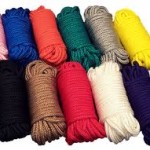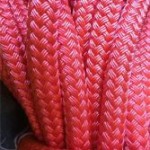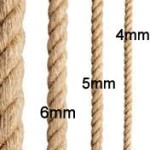You’re ready to tie your lover up tonight. Do you run out to the hardware store and pick up some rope? Do you have to order something special? There’s so many options, how do you choose?
The short answer, it all depends on your personal taste and what type of bondage you’re delving into. To help make your decision easier, let’s take some time to look at the differences between common types of rope.
Rope is typicaly broken up into two categories; natural and synthetic. Both can be used for bondage. However, each has its own properties and may perform differently in certain situations.
*
*
Natural Fiber Ropes:
Natural fiber ropes are twisted rather than being braided. Many prefer these ropes because of the aesthetically pleasing marks it leaves behind on the skin. Natural fiber ropes are strong and have enough friction to securely hold knots.

Hemp – Hemp fibers can from various strains of the Cannabis sativa plant. It’s strong, durable and has friction to hold knots securely. However, it has a bit more stretch then Jute rope. Untreated Hemp rope is fairly rough and has a very distinctive smell. Although, it can be processed and treated to make it soft and odor free. Hemp is the most common rope used for Shabari rope bondage in the West.

Jute – Jute rope comes from plants in the Corchorus genus, a long shiny vegetable fiber. Similar to Hemp, it’s lighter smoother and has a different smell. Strong and well suited for bondage, the knots compress easier making them look neater. In Japan, Jute is the preferred rope for bondage.
Linen – Linen rope comes from the flax plant and is produced similar to Hemp rope. Different from either Hemp of Jute, it’s fluffier, softer, and very smooth. It holds knots well and is fairly strong. However it has a little stretch.

Cotton – Very different from other natural fiber ropes, Cotton can be made twisted or braided. Much softer than other ropes, it feels plush and subtle against the skin. It has very little friction allowing knots to easily slip under tension. Cotton rope stretches when used, making knot more difficult to undo. Suitable for floor work and photography, it’s not recommended for load bearing bondage
Manila – Made from the leaf steams of the abaca plant, a member of the banana family. The fibers are hard and thicker. Easily broken, they can leave splinters on your rope bottom. Although it’s easily found, this type of rope isn’t suitable for bondage.
Sisal – Made from plants in the agave family, its fibers are hard, coarse, and weak.
Coir – Produced from the outer fibers of coconut husks, this rope is hard and rough on the skin. The thick fibers splinter easy making it unsuitable for bondage.
*
*
Exotic Ropes –
 Bamboo – Hand spun Bamboo is soft, strong, flexible, and breathable. It’s light weight and knots easily. Bamboo rope also has antibacterial properties. Beautiful for photography and artistic photos, it has a pearly luster. Bamboo also takes dye wonderfully and is available in wide array of colors.
Bamboo – Hand spun Bamboo is soft, strong, flexible, and breathable. It’s light weight and knots easily. Bamboo rope also has antibacterial properties. Beautiful for photography and artistic photos, it has a pearly luster. Bamboo also takes dye wonderfully and is available in wide array of colors.
Silk – Hand spun, this rope is made from raw silk. The fiber is naturally strong a holds knots easily. It’s soft, rich, and subtle on the skin. Easily dyed, it’s offered in a variety of colors.
Cashmere – Hand spun, typically from Mongolian cashmere. Similar to Bamboo, it has some stretch. When working with it, cashmere has a low burn and feels heavenly on your bottoms skin. Its natural color can vary from white to pale tan. Also, Cashmere gets softer with use.
*
*
Synthetic Ropes
In the West, synthetic ropes are popular due to their low cost and dye ability Also, synthetic ropes don’t shrink and are great to use for photo shoots involving water.

Nylon – Nylon is the most common synthetic rope used for bondage, It’s smooth and soft against the skin, feeling similar to cotton. Strong and easy to work with, it’s popularity is understandable. However, it’s a bit slick and has less friction to hold knots securely than natural fibers. Many times, extra knots or wraps are required to hold the rope work firmly in place. In addition, it has a bit of stretch while you use it. Very popular for bondage photos involving water, Nylon doesn’t shrink and ‘pops’ on camera. Typically braided, it can also be found twisted.

Dacron – Similar to Nylon, Dacron has less stretch. Extremely strong and durable, Dacron rope is sometimes used for sailing because it’s water resistant. Normally found at craft stores, it comes in a wide array of contrasting colors.
Rayon – Has all of the advantages of Nylon. However used mainly for sail boating, it’s too expensive for bondage play.

Parachute Cord – Very strong, this rope is soft and holds knots well. However, it’s only available in small diameters. Good for corseting, CBT or small ties, it comes in a wide array of colors. When using Parachute Cord, care must be used to avoid rope burn.
Polypropylene – This rope is widely available. However, it’s rough, scratchy, and doesn’t hold knots well; making it unsuitable for bondage.
Multi-Filament Polypropylene – Softer than traditional polypropylene rope, it has a greater risk for rope burn than natural fibers. It has very little stretch, but is still not ideal for fun bondage.

Climbing ropes – These ropes are also very strong. However, in general, the thick size of this rope causes the knots to be big and bulky for bondage.
Kevlar – Kevlar fibers are used for bulletproof vests. The rope is strong and usually made as part of a Dacron braid. Very expensive, it’s not suitable for bondage play.
Most synthetic rope comes with an inner core which can be removed allowing the rope to lay flat when you use it. However, removing the core can diminish the load bearing ability of your rope giving it a low breaking point.
*
*
Diameter of Rope

A good all around size for bondage is 6mm ¼ inches in thickness. It looks aesthetically pleasing and doesn’t put undue stress on the body through using multiple body wraps. 6mm is the most common size used for floor work and also suspension.
4 and 5 mm ropes are good for decorative bondage and holds knots tighter than larger options. However, when pulled tight, they tend to dig into the rope bottom’s skin. Usually used for micro bondage, this rope works well for corseting, binding the digits, male genital or even face bondage.
8mm rope is appealing. However when using it, the rope makes bigger knots or intersection that are easier to slip out of. Used in some situations, this size rope works well when fewer wraps are used or for suspension of larger bodied rope bottoms.
*
*
Length
It’s easier to keep all of your ropes around the same length. Ropes can be lashed together when more is needed or wrapped when less is needed. Adapting your ties is easier than keeping up with the different lengths for different situations.
By far the most popular length is 23 or 25 feet. Sometimes shorter 10 foot ropes will be used for binding the limbs or elaborate body harnesses. However, in Japan, all ropes used are 7 meters long (22 feet) and have knots on the ends to allow adjoining ropes.
In addition, to cut down on confusion, many riggers will lash the ends of their rope in colors representing the rope’s length.
*
*
When selecting your rope, there are several aspects to consider.
Comfort – Do you want your sub to be comfortable or do you prefer a rougher feeling on the skin?
Purpose – Is your bondage for floor work or simple restraining? Are you suspending your sub or participating in an elaborate bondage scene?
Aesthetics – Do you like the traditional look of rope on the skin or the lovely marks left behind by it? Do you desire to see vivid colors against your subs skin?
Health Considerations – Natural fibers could irritate people or produce an allergic reaction in sensitive people. It’s best to test rope on those with sensitivities by tying a piece around their wrist controlling the results. If there is swelling or inching, don’t use that type rope.
No matter what type of play or look you’re going for, there’s a rope that’s just right. Equipped with all I can find to share about the rope varieties available, it’s my hope that you’ll find the one that’s right for your fun.

Thank you for the article Lori. Since we also love playing with hemp rope, and sell it as you know, I’d like to add that hemp rope also won’t burn your skin when you pull it through fast. Also, it is great to photograph.
I also find that the most bought length is 30′, which is great for chest harnesses, or body harnesses on smaller people.